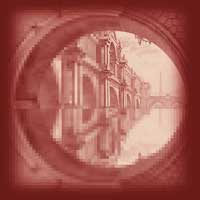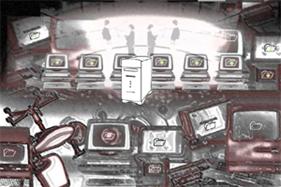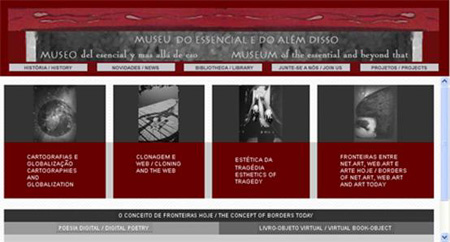"Museum of the essential and beyond that", Architecture of Information or Creative Interface?
Regina Célia Pinto
1. The Essential
"We believe that within the creation of a new style there lurks the sublime possibility of making life bearable."[1]
In the modern city, the value of the individual is constantly falling. The city that was once essentially a safe haven has become a place of despair, loneliness, the struggle for survival. The city as a cultural hub has become a privilege of few.
The metropolis is found throughout the world, an economically passive and politically ungovernable organism, dangerous to the physical and mental health of its inhabitants. The great disparity between the standard of living of the economic classes has come to exclude the underprivileged from the enjoyment of the cultural asset the city represents.[2]
Sociologists such as Michel Maffesoli [3] have studied the phenomenon of tribalism in contemporary societies as a possible response to the experience of loss and loneliness that people undergo in large cities, where mass culture and individualism predominate. "From more than one point of view, social existence is alienated, subjected to the injunctions of a multifarious Power. However, it is also true that there is an affirmative Potency that, in spite of everything, (always) plays the game over, beginning with solidarity and reciprocity." [4]
The emergence of virtual communities is reaffirming that potency. In them, as the great French thinker Marcel Mauss [5] has stated, everyone seems to be interested in an alternatively shared and solitary project; in accumulated and redistributed knowledge; in the mutual respect and reciprocal generosity taught by good breeding. Therefore, it is easy to understand the success of a project like the "Museum of the Essential and Beyond That," which is not connected to an institution and does not rely on any kind of financial support or sponsorship. It is being undertaken on a home computer in the city of Rio de Janeiro but has a dynamic digital model, a constant state of becoming, and for that reason receives contributions from different latitudes and longitudes of this geography without borders created by information technologies. A world that seems to be turning to virtual communities as a way of building a better future.
Cyberspace can eliminate distances between its occupants, although it is merely canceling out a symbolic distance through digital communication. What does cyberspace look like? What does a museum with all its galleries and libraries look like out in cyberspace? A "cyber-museum" is a spatial-temporal shape built up through movement: transportation and communication. During the process of creating a virtual museum, we cannot overlook the paths people follow through information and that this must be a place where information is shared intensively by all its visitors and participants.
2. What exactly is a "Museum of the Essential and Beyond That"?
This project consists of the creation of virtual architectures: a museum with its libraries and galleries that have no brick-and-mortar counterparts. It is common for real museums and libraries to have websites, but the process underway in our "museum" is rather uncommon. A museum that does not exist in the real world, and whose architecture and collections are formed by a string of digits: 01010101. Is it just an electronic clearinghouse for bits and bytes?
The museum started out as a "work in progress": so is it information architecture? But it is also an imaginary two-story pixel-building with a basement… The building's architectural design can be changed at any time, whether by constructing another story or changing part of its shape - a Niemeyer design [6], constellation, space station, Piranesi engraving [7]: creative interface?… This museum was conceived as an open structure in which information is spread out in a number of spaces; a machine that can travel infinitely in all directions.
Fig. 1: Architecture — Piranesi engraving
For example, the Library of Marvels is located on the first (ground) floor of the building and contains some of the artist's e-books, a list that will gradually lengthen. It currently contains The White and the Black, Reflections on Fog; Book of Sand, The Alienist, net . art / web . art and other stories (this book contains a different virtual architecture: the animated series Green House, which not only presents an image of cyberspace but an image of itself, and aims at being a cyber-region for artists who work with net or web.art). The objective of this project within the Museum project is to take a closer look at the cultural impact and possibilities created by computers as machines that can produce books and libraries and the boundary between traditional books and electronic books.
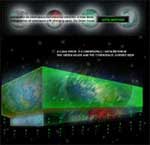
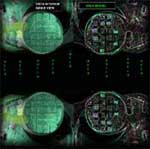
Fig. 2: Cyberspace and Green House Fig. 2: Green House (interior)
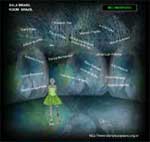
Fig.3: Brazil Room
All the books in the Library of Marvels are based on masterworks from the universal literature and ancient games, and are also multimedia/hypertexts by this author. The desire to broaden this space led me to invite other authors to participate. The first resident writer was Joel Weishaus (Center for Excellence in Writing, Portland State University Portland, Oregon) who contributed Traces of the Catacombes, which takes its name from the "hollow (hallowed) ground" of Early Christianity, excavated in what was then the suburbs of Rome. But there are other catacombs, such as those beneath Paris, and other issues to be uncovered; so that the title plays on the name of French artist Mireille W. Descombes.
The same floor of the museum also contains another library that is intended to be specialized, gradually building up a virtual bibliographic collection on art and technology. Exactly like a real library, each book has or will have its own reference card. Rooms for magazines, interviews/statements and essays are also found on this floor.
The museum's contents were selected on the basis of the essential criteria of contemporaneousness and quality. The line of Contemporary Art that specifically interests us is Art and Technology. Most artists and members of the public are unaware that the computer is much more than a tool. It is actually giving rise to new artistic languages. And the "Museum of the Essential and Beyond That" is investing precisely it is in these languages and the contemporaneity of this proposition. For that reason, we emphasize experiments in digital poetry, because we believe that only now has visual poetry found the support it required and has been imagined since Stéphane Mallarmé [6].
For example, our digital poetry collection contains the Arteroids 2.03 Game by Canadian artist Jim Andrews (http://www.vispo.com), who writes, "The game is the battle of poetry against itself and the forces of dullness, an Internet 'movie' in Macromedia Director Shockwave, a computer game of 216 levels, and a re-write of the possibilities of digital poetry."As regards digital poetry, we could not fail to mention the Spam Room, where we find Spams Trashes by the Uruguayan poet Clemente Padín. Is this poetry? Is this art? Visit the room and send a friend something of this climate of creation, reflection, humor, irony and the desire for a better world…
The following is a list of the Museum's active galleries and the artists found in each:
I - Basement:
ESTHETIC OF TRAGEDY: Carlos Zerpa (Venezuela), Caterina Davinio (Italy), Clemente Padín (Uruguay), Daniel Acosta (Argentina), Déa Junqueira (Brazil), Hilda Paz (Argentina), Joesér Alvarez (Brazil), Léo Caraffa (Brazil), Leonardo Lezcano (Spain), Marcelo Frazão (Brazil), Miekal And (United States), Neide Sá (Brazil), Paulo Villela (Brazil), Regina Célia Pinto (Brazil), Wilfried Agricola of Cologne (Germany)
TRAGICOMEDY: Marcelo Frazão (Brazil), Paulo Villela (Brazil) and Regina Célia Pinto (Brazil)
SPECIAL ROOM: Regina Célia Pinto (Tribute to Goya)
II- First (ground) floor:
DIGITAL POETRY: Ana Maria Uribe (Argentina), Alexandre Venera (Brazil) and Clemente Padín (Uruguay), David Daniels (United States), Jim Andrews (Canada), JoesérAlvarez (Brazil), Jorge Luiz Antonio (Brazil), Regina Célia Pinto (Brazil)
VIRTUAL BOOK-OBJECT: Barry Smylie, Jeff Wietor , Ryan Douglas and Suzan Katz (Canada and United States), Blas Valdez (Mexico), Regina Célia Pinto (Brazil)
III- Second floor:
CLONING AND THE WEB: Babel (Canada), Isabel Aranda (Chile)
CONCEPT OF BORDERS TODAY: Alan Sondheim (Estados Unidos), Antonio Alvarado (Spain), Barry Smylie (Canada) and Ryan Douglas (United States), George Hartley (United States) and Juan Felipe Herrera (Mexico), Lewis Lacook (United States), Miguel A. Jimenez (Spain), Suely Farhy (Brazil), Wilfried Agricola of Cologne (Germany).
CARTOGRAPHIES AND GLOBALIZATION: Caterina Davinio (Italy), Giovanni Strada (Italy), Helenice Dornelles (Brazil), Lia Belart (Brazil), Luc Fierens (Belgium), Marcelo Frazão (Brazil), Muriel Frega (Argentina), Nilda Saldamando (Chile), Ricardo Corona and Eliane Borges (Brazil), Sandra Miguélez and Rafael González (Spain), Tulio Restrepo (Colombia).
BORDERS BETWEEN NET.ART - WEB.ART AND ART TODAY: Álvaro Ardevol (Spain), Barry Smylie (Canada) and Ryan Douglas (United States), Brad Brace (United States), Diana Domingues and Artecno Group (Brazil), Frédéric Durieu and Jean-Jacques Birg (France), Guto Nóbrega (Brazil), Jim Andrews (Canada), Joesér Alvarez (Brazil), Isabel Aranda (Chile), Reiner Strasser (Germany), Regina Célia Pinto (Brazil), Sarawut Chutiwongpeti (Thailand)
SPAM ROOM: Clemente Padín (Uruguay)
IV- Attic:
We recently added an attic to the Museum's structure to house a collaborative project carried out with Reiner Strasser (http://netartefact.de), a German from Wiesbaden. Reiner Strasser and I created and opened this new gallery. In the attic we are exhibiting the old computers we have used to create web, net.art and digital art and some of the creations made with those machines. These "avatars" of old equipment and works made with them are not just "cool memories." They are also a way of ethnographically and humorously suggesting that we should start to think about the preservation of this kind of virtual culture. The attic gallery opened in September 2002 and is now home to the following artists: Agricola of Cologne (Germany), Alexandre Venera (Brazil), Ana Maria Uribe (Argentina), Barry Smylie (Canada), David Daniels (USA), Duc Thuan (Vietnam), Komninos Zervos (Australia), Millie Niss (USA), Muriel Frega (Argentina), Phillipe Castellin ( France), Reiner Strasser (Germany) and Regina Célia Pinto (Brazil).
Fig.5: The Attic
V - Browsing:
Visitors can browse the Museum's many areas in two ways - through the links on the following page, http://www.arteonline.arq.br/museu/home2 (fig. 6); or through its side view (fig. 7) and ground plans (fig. 8)… To access this means of browsing, just click on the Museum logo (fig. 9) on the above-mentioned page. This way of browsing the floor plans simulates a real-life tour of the Museum's virtual space.
Fig.6: Browsing menu: Home2 page
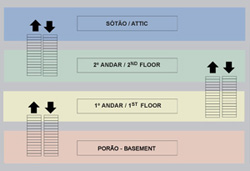
Fig. 7: Side View
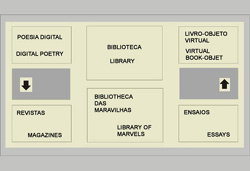
Fig. 8: First floor ground plan
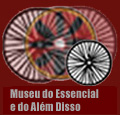
Fig. 9: Museum's logo
Everything is always perfect in the virtual cities found on the Internet, but the Museum's space does not work that way. Instead, its operations aim at fulfilling the dictates of the principle of reality. For example, tragedy and its esthetic or things we really do not want to think about, have been shifted (with a touch of morbid humor) to the basement. Bit by bit, we intend to place some problems in the Museum building, because we do not intent it to become an aseptic parody of a real museum. We predict the need to restore this cultural machine once it has become the victim of its own success and the enormous number of visitors it attracts. Every once in a while, a room or gallery could be shut down for repairs. The Museum's order could also be disturbed by power struggles involving both political power and that of feudal corporations, so common in institutions of this kind…
3 - Beyond thatThe fact is that this project, justifying the beyond that in its name, is fast becoming a cultural center where a mouse click offers both a museum and a place for creation and communication where the visual arts are joined by music, filmmaking (animation), poetry, books and audiovisual research. "This characteristic is related to the aim of modern-day art, which is to embody in its works certain new forms of beauty that could only emerge through the reconvergence of all techniques" [8] and technologies... Since its inception, at the Museum of the Essential and Beyond That, this reconvergence has been present in its watchwords: communication, information, multidisciplinarity, multiculturalism and mobility. Science and technology embracing art to protect it and give it the necessary conditions for life and growth.
4- References:
[1] In MAFFESOLLI, Michel (1995). A contemplação do mundo. Porto Alegre: Artes e Ofícios.
[2] ARGAN, Giulio Carlo. História da arte como história da cidade. São Paulo: Martins Fontes, p. 258.
[3] Michel Maffesolli , a contemporary French sociologist, analyzes this subject in his book The Time of the Tribes, Sage, 1996.
[4] MAFFESOLLI, Michel. The Time of the Tribes. Op cit.
[5] MAUSS, Marcel. Ensaio sobre a dádiva. Lisbon: Edições 70, 1988.
[6] Oscar Niemeyer: contemporary Brazilian architect and creator of Brasilia, a monument-city and treasure of humanity. (http://www.niemeyer.org.br/)
[7] Piranesi: eighteenth-century architect,, artist and engraver, in FICACCI, Luigi. Giovanni Battista PIRANESI. Germany: Taschen, 2001.
[8] FRANCASTEL, Pierre. Art et technique aux XIX et XX siècles. Paris: Éditions Minuit, 19565- Bibliography
BACHELARD, Gaston. A poética do espaço. Rio de Janeiro: Livraria Eldorado Tijuca Ltda, s.d.
BAUDRILLARD, Jean. A ilusão vital. São Paulo: Civilização Brasileira, 2002
___________________. Simulacros e simulações. Lisboa: Relógio d' Água Editorial, 1991
BERNARDO, Gustavo and MENDES, Ricardo (organizers). Vilém Flusser no Brasil. Rio de Janeiro: Editora Relume Dumará, 1999.
DOMINGUES, Diana (organização). A arte no século XXI: a humanização das tecnologias.São Paulo: Unesp, 1997.
__________________.Criação e interatividade na ciberarte. São Paulo: Experimento, 2002.
GEERTZ, Cliford. A interpretação das culturas. Rio de Janeiro: Editora Guanabara, 1989.
LEÃO, Lúcia. A estética do labirinto. São Paulo: Anhembi Morumbi, 2002.
LÉVY, Pierre. A Inteligência Coletiva. São Paulo: Edições Loyola, 1998.
___________. A máquina universo. Porto Alegre: Artemed, 1998.
___________. O que é virtual? São Paulo: Editora 34, 1996.
MAFFESOLLI, Michel. The Time of the Tribes. Sage, 1996. (Brazilian edition: O tempo das tribos. Rio de Janeiro: Forense Universitária, 1987.)
MAUSS, Marcel. Ensaio sobre a dádiva. Lisbon: Edições 70, 1988.
PANOFSKI, Erwin. A perspectiva como forma simbólica. Lisbon: Edições 70, 1993.
PINTO, Regina Célia and ANTONIO, Jorge Luiz. Algo no lago: uma experiência em net.poesia. Rio de Janeiro: multimedia publication - CD-ROM, 2002.
SILVEIRA, Paulo. A página violada: da ternura à injúria na construção do livro de artista. Porto Alegre: Editora da Universidade, UFRGS, 2000.Websites:
LEMOS, André. Ciber-cidades. http://www.facom.ufba.br/ciberpesquisa/lemos/cibercidade.html
LEMOS, André. Ciber-tribus.
http://cibersociedad.rediris.es/congreso/comms/g06borges.htmFLOETING , Holger . Virtual Cities?! - Telematics and Spatial Development
http://www.difu.de/index.shtml?/english/occasional/virtual_cities
